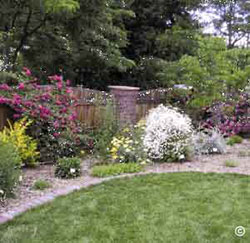In the high plains grasslands, dead grass and plants accumulate. These plant remains are natural mulches and are a great benefit for growing plants. They keep the soil moist and loose (increasing the soil’s ability to retain moisture), permit air and water to pass freely to plant roots, and reduce soil erosion and weeds.
What is the benefit of adding mulch to a yard?

Following Mother Nature’s example will provide those same benefits in a yard. A layer of mulch when xeriscaping keeps soil cooler and reduces evaporation so less water is needed. Mulches can also reduce weeds and can add color and texture to a landscape.
What are the different types of mulch?
There are basically two kinds of mulches—organic and inorganic. In Colorado the most common organic mulches include wood chips, chunk bark, shredded bar, pine needles, lawn clippings and straw. Organic mulches gradually break down and add nutrients to the soil. They will need to be renewed periodically. Decomposition of fresh wood mulches can create nitrogen deficiencies. Be prepared to supplement the area with a fertilizer.
Inorganic mulches are stone-based and include rock, cobblestone, pea gravel, lava rock and crushed rock. They last longer than organic mulches and give landscapes a more formal look. Apply about 3” of mulch for weed control. Use less directly around the plants to allow water to reach the root area. Inorganic mulches also store and radiate heat, so avoid putting large areas of unshaded rock next to a house.
Installing sheet plastic underneath mulches is not a good idea. Air and moisture don’t permeate plastic, so plant roots don’t develop, but weeds can come through the plastic. Instead, use an air- and water- permeable landscape fabric under the mulch if an additional weed barrier is needed.
By using mulch, you’ll have a beautiful yard and save water, too.
For more information, see the following Planttalk Colorado™ video(s).
For more information, see the following Colorado State University Extension fact sheet(s).



